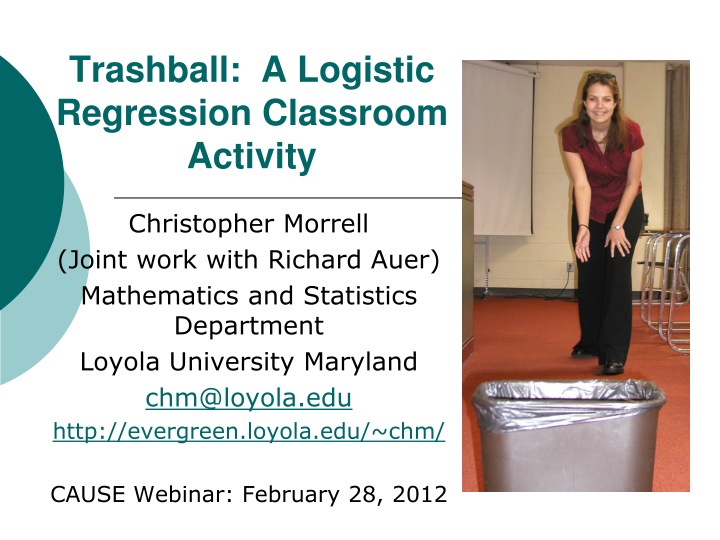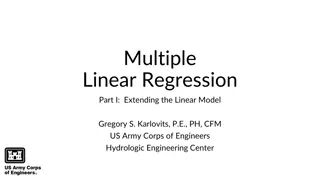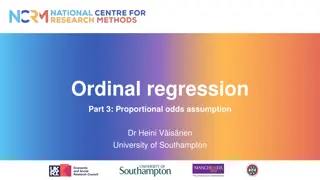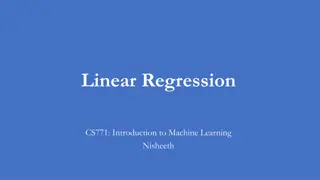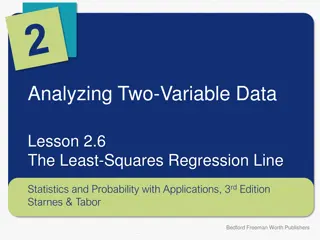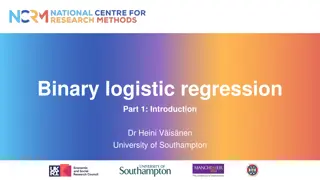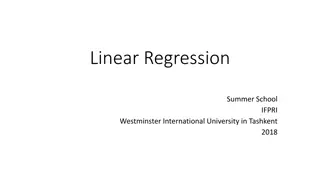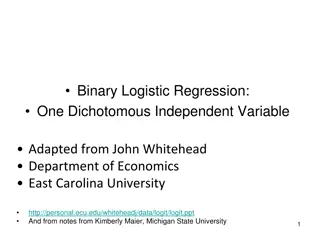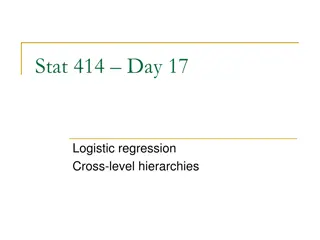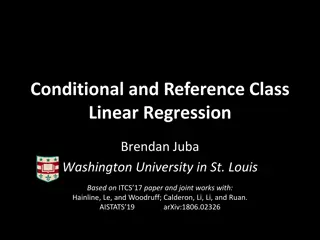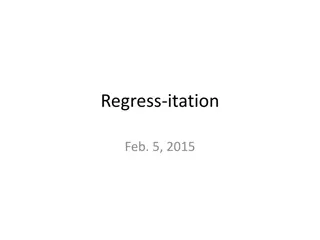Trashball Logistic Regression Classroom Activity
Statistical methods in linear models courses often discuss response variables that are binary or categorical. Logistic regression is increasingly included in introductory materials, such as Trashball, where students attempt to make shots into a trashcan based on various factors like distance and ball type.
Download Presentation

Please find below an Image/Link to download the presentation.
The content on the website is provided AS IS for your information and personal use only. It may not be sold, licensed, or shared on other websites without obtaining consent from the author.If you encounter any issues during the download, it is possible that the publisher has removed the file from their server.
You are allowed to download the files provided on this website for personal or commercial use, subject to the condition that they are used lawfully. All files are the property of their respective owners.
The content on the website is provided AS IS for your information and personal use only. It may not be sold, licensed, or shared on other websites without obtaining consent from the author.
E N D
Presentation Transcript
Trashball: A Logistic Regression Classroom Activity Christopher Morrell (Joint work with Richard Auer) Mathematics and Statistics Department Loyola University Maryland chm@loyola.edu http://evergreen.loyola.edu/~chm/ CAUSE Webinar: February 28, 2012
Background Statistical methods or linear models courses initially discuss continuous numerical response variables. Can also consider response variables that are either binary or categorical. More introductory linear models and statistical methods books now include chapters or sections devoted to logistic regression (for example, see Kleinbaum et al. (2008), Kutner et. al. (2003), Ott, and Longnecker (2010)).
Trashball: The Activity Students attempt to toss a ball into a trashcan. The outcome or response variable is whether or not the ball ends up in the trashcan - ShotMade. Success depends on the distance from the trashcan (and other factors).
Design and Explanatory Variables Four factors in the design of the experiment in the Fall of 2003: o distance from the trashcan (from 5 to 12 feet), o orientation of the trashcan, o gender of the student, and o type of ball used (tennis ball or racquetball).
Design and Explanatory Variables (Continued) The settings of the explanatory variables make up the design of the experiment. The various factors should be balanced across the experiment so that interaction terms can be estimated. This may be difficult to achieve; some of the students were absent on the day of the experiment. To increase the sample size, each student makes three attempts from varying combinations of distance, orientation, and type of ball. The repeated observations may induce some non- independence and this should be mentioned during the execution of the experiment.
Design Results Gender Gender Male Total Male Female Total Female 9 12 21 Narrow 9 12 21 Raquet 9 12 21 Wide 9 12 21 Tennis 18 24 42 Total 18 24 42 Total
Design Results Orientation Wide Total Narrow 10 11 21 Raquet 11 10 21 Tennis 21 21 42 Total
Design Results Shot Distance (in feet) 5 6 7 8 9 10 11 12 Total Raquet 3 2 3 3 2 3 2 3 21 Tennis 3 2 3 2 3 3 2 3 21 Total 6 4 6 5 5 6 4 6 42
Design Results Shot Distance (in feet) 5 6 7 8 9 10 11 12 Total Narrow 5 0 5 0 5 2 4 0 21 Wide 1 4 1 5 0 4 0 6 21 Total 6 4 6 5 5 6 4 6 42
Design Results Shot Distance (in feet) 5 6 7 8 9 10 11 12 Total Male 2 2 3 2 2 3 2 2 18 Female 4 2 3 3 3 3 2 4 24 Total 6 4 6 5 5 6 4 6 42
Classroom Presentation As Trashball is described, the students begin to realize that the response variable has only two outcomes. Assumptions of linear regression not valid. Linear regression may lead to predictions that are negative or greater then one. We are actually trying to model the probability of a success - the results must be values between 0 and 1. Introduce the logistic regression function and explain its properties. Enter the data into Minitab as the activity progresses. The results are immediately displayed using a classroom projection system.
Results of Activity 1.00 The activity was conducted in subsequent offerings of Experimental Research Methods, a junior/senior level course taken by majors and minors. Here I present the actual data collected from the activity in the fall of 2003. 0.75 Shot Made 0.50 0.25 0.00 5 6 7 8 9 10 11 12 Distance Figure 1. Shot Made vs. Distance. Jitter is added to the points to show the repeated observations. The Lowess curve is overlaid.
Minitab Output 1. Logistic regression for shot made with distance. Binary Logistic Regression: ShotMade versus Distance Link Function: Logit Response Information Variable Value Count ShotMade 1 25 (Event) 0 17 Total 42 Logistic Regression Table Odds 95% CI Predictor Coef SE Coef Z P Ratio Lower Upper Constant 5.204 1.695 3.07 0.002 Distance -0.5499 0.1842 -2.98 0.003 0.58 0.40 0.83
Minitab Output 1. (Continued) Log-Likelihood = -22.294 Test that all slopes are zero: G = 12.102, DF = 1, P-Value = 0.001 Goodness-of-Fit Tests Method Chi-Square DF P Pearson 5.542 6 0.476 Deviance 6.488 6 0.371 Hosmer-Lemeshow 5.542 6 0.476 Table of Observed and Expected Frequencies: (See Hosmer-Lemeshow Test for the Pearson Chi-Square Statistic) Group Value 1 2 3 4 5 6 7 8 Total 1 Obs 2 1 3 1 4 4 4 6 25 Exp 1.2 1.2 2.6 2.8 3.5 4.8 3.5 5.5 0 Obs 4 3 3 4 1 2 0 0 17 Exp 4.8 2.8 3.4 2.2 1.5 1.2 0.5 0.5 Total 6 4 6 5 5 6 4 6 42 The goodness of fit tests indicate that this model provides an adequate description of this data.
Fitted Logistic Model 1.0 0.8 Shot Made 0.6 P(Shot made | distance x) = 0.4 0.2 exp(5.204 + - 0.5499 x) 0.0 1 exp(5.204 - 0.5499 x) 2 4 6 8 10 12 14 Distance Figure 2. The fitted linear and logistic regression models.
Minitab Output 2. Multiple Logistic regression Binary Logistic Regression: ShotMade versus Distance, Ball, Orientation, Gender Logistic Regression Table Odds 95% CI Predictor Coef SE Coef Z P Ratio Lower Upper Constant 5.782 1.990 2.91 0.004 Distance -0.7649 0.2349 -3.26 0.001 0.47 0.29 0.74 Ball 0.6156 0.8437 0.73 0.466 1.85 0.35 9.67 Orientation 2.420 1.015 2.38 0.017 11.24 1.54 82.16 Gender -0.1532 0.8330 -0.18 0.854 0.86 0.17 4.39 Log-Likelihood = -18.394 Test that all slopes are zero: G = 19.904, DF = 4, P-Value = 0.001
Minitab Output 3. Final multiple logistic regression Binary Logistic Regression: ShotMade versus Distance, Orientation Logistic Regression Table Odds 95% CI Predictor Coef SE Coef Z P Ratio Lower Upper Constant 5.857 1.913 3.06 0.002 Distance -0.7425 0.2282 -3.25 0.001 0.48 0.30 0.74 Orientation 2.3096 0.9827 2.35 0.019 10.07 1.47 69.11 Log-Likelihood = -18.684 Test that all slopes are zero: G = 19.323, DF = 2, P-Value = 0.000 Goodness-of-Fit Tests Method Chi-Square DF P Pearson 3.441 8 0.904 Deviance 3.994 8 0.858 Hosmer-Lemeshow 3.316 7 0.854
Observed proportion and modeled probabilities by orientation and distance. Shot Distance (in feet) Observed Probability Wide/ Shallow Narrow/ Deep 5 6 7 8 9 10 11 12 1.00 0.895 0.60 0.659 0.20 0.305 0.00 0.173 0.25 0.090 - - - 1.00 0.989 1.00 0.976 1.00 0.951 0.80 0.903 0.75 0.677 0.33 0.322 - -
Conclusions Chapters or sections on logistic regression are appearing more frequently in texts on statistical methods/linear models. Trashball may be used to motivate the use of logistic regression to model a binary response variable. Our students had fun! When conducting a mid-semester evaluation of the course, one student responded More Trashball. Suggested modifications: o Use balls that are more different (tennis and table tennis). o Hand student uses to toss the ball (writing hand, other hand). JSE paper: http://www.amstat.org/publications/jse/v15n1/morrell.html
